



Allergies Away
Allergies Away delivers relief where others fail:
- specifically formulated for dry environments
- used for symptoms of hay fever such as sneezing, runny nose and itchy, watery eyes
- won’t leave you feeling drowsy
Available in 2-ounce and 4-ounce sizes.
Description
Allergies Away is uniquely formulated to moisten the nasal passageways while addressing symptoms associated with seasonal allergies and hay fever. Because it contains ingredients which moisten the nose and sinuses, Allergies Away won't leave you feeling dried out like other herbal or over the counter remedies.
Allergies Away is based on the Chinese herbal remedy Sang Ju Yin (Mulberry and Chrysanthemum). This remedy has been used for centuries to relieve symptoms such as sneezing, runny nose and red, itchy, watery eyes.
We augment this formula by adding herbs which moisten the nose and eyes as well as herbs which gently transform phlegm. The result is a balanced herbal remedy which addresses allergies without leaving you feeling dried out.
Ingredients
-
Mulberry Leaf (Sang Ye)
Mulberry leaf comes from the mulberry tree. It clears heat from lungs, stops coughing and moistens dryness.
-
Chrysanthemum (Ju Hua)
Chrysanthemum is a flowering plant and the flowers are used as medicine. It disperses wind, clears heat and stimulates blood circulation.
-
Apricot Seed (Xing Ren)
Apricot seed contains a variety of amino acids and other substances, including oleic and linoleic acid. One of the components of apricot seed, amygdalin, has been shown to reduce the incidence and severity of coughing.
-
Platycodon (Jie Geng)
Platycodon is a perennial plant that grows to a height of about three feet. The plant is characterized by its flower buds which, when unopened, resemble small, inflated balloons. The main and secondary roots are used medicinally. It opens lungs and expels phlegm.
-
Forsythia (Lian Qiao)
Forsythia is a hardy tree and the fruit of the forsythia is used medicinally. The fruit is steamed, dried in the sun, and the seeds removed from the fruit before used in herbal remedies. It clears heat.
-
Phragmites (Lu Gen)
Phragmites is the name given to species of aquatic grasses. The grasses can reach a height of 5 and 15 feet, with feather-like flowers and thin, stiff, hollow stems. The rhizomes are used in herbal preparations, which are dug up at the end of spring or in the fall and removed of fibrous material. It clears heat from the lungs.
-
Licorice (Gan Cao)
Licorice has been used to flavor foods for centuries. Licorice root is used medicinally. The two most important components of licorice are glycyrrhizin and flavonoids. Glycyrrhizin works as an anti-inflammatory and antiviral and inhibits the breakdown of cortisol. It also augments Qi, moistens lungs, resolves phlegm and stops coughing.
-
Xanthium (Cang Er Zi)
The pods, or fruit, are used in medicine, and are referred to as cang er zi based on their color and appearance. It unblocks nasal obstruction.
-
Magnolia Flower (Xin Yi Hua)
Magnolia flowers come from the magnolia tree. The flowers are cuplike and fragrant, with between six and 12 petals apiece, and range in color from white to pink to purple. The flower buds and petals are collected in early spring when the bud is not in blossom, then dried in the sun and cleared of debris for use in herbal preparations.It unblocks nasal obstruction and sinus headache.
-
Angelica Root (Bai Zhi)
A graceful flowering plant related to carrots, dill, and fennel. The plant has an intense yet sweet aroma more like carrots than like dill or fennel. it expels wind, eliminates dampness, unblocks nasal passages.
-
Equisetum (Mu Zei)
Also known as horsetail because of its shape, it is found throughout the temperate zones of Asia, North America and Europe. Bottle brush is a rich source of essential nutrients; among its constituents are silicon, potassium, selenium, aluminum and manganese, along with 15 types of bioflavonoids. The stems and leaves are used medicinally, which clears heat and disperses wind-heat.
-
Prunella (Xia Ku Cao)
Prunella is a small yet hearty herb found throughout temperate regions. The plant goes by a variety of names, including self-heal, carpenter’s weed and sicklewort. It consists of an extremely thin stem that reaches a height of up to 18 inches, with dark, reddish leaves and blue-violet or bluish-brown flowers. The flowering part of the plant is used medicinally which clears hot phlegm.
-
Ophiopogon (Mai Men Dong)
Ophiopogon is a small herb grown in small parts of China. The plant has long, thin green leaves and tuberous whitish roots, which are used in a variety of herbal remedies. It is typically harvested in the summer and allowed to dry out before use. It clears heat and moistens the body.
-
Sanguisorba (Di Yu)
Sanguisorba is a perennial herb found throughout China. It can reach a height of 3 feet, with thing, upright stems and club-shaped clusters of flowers. The plant's roots are used in herbal preparations. The roots are typically dug up in the spring and autumn. After any loose fibrous material is removed, the roots are cleaned, dried in the sun, then cut into slices. It cools the blood and clears toxic heat.
-
Liquidambar (Lu Lu Tong)
The sweetgum tree produces hard, dry, fruit. When the fruit opens the seeds are released and used in herbal preparations. It invigorates blood and promotes movement of Qi.







